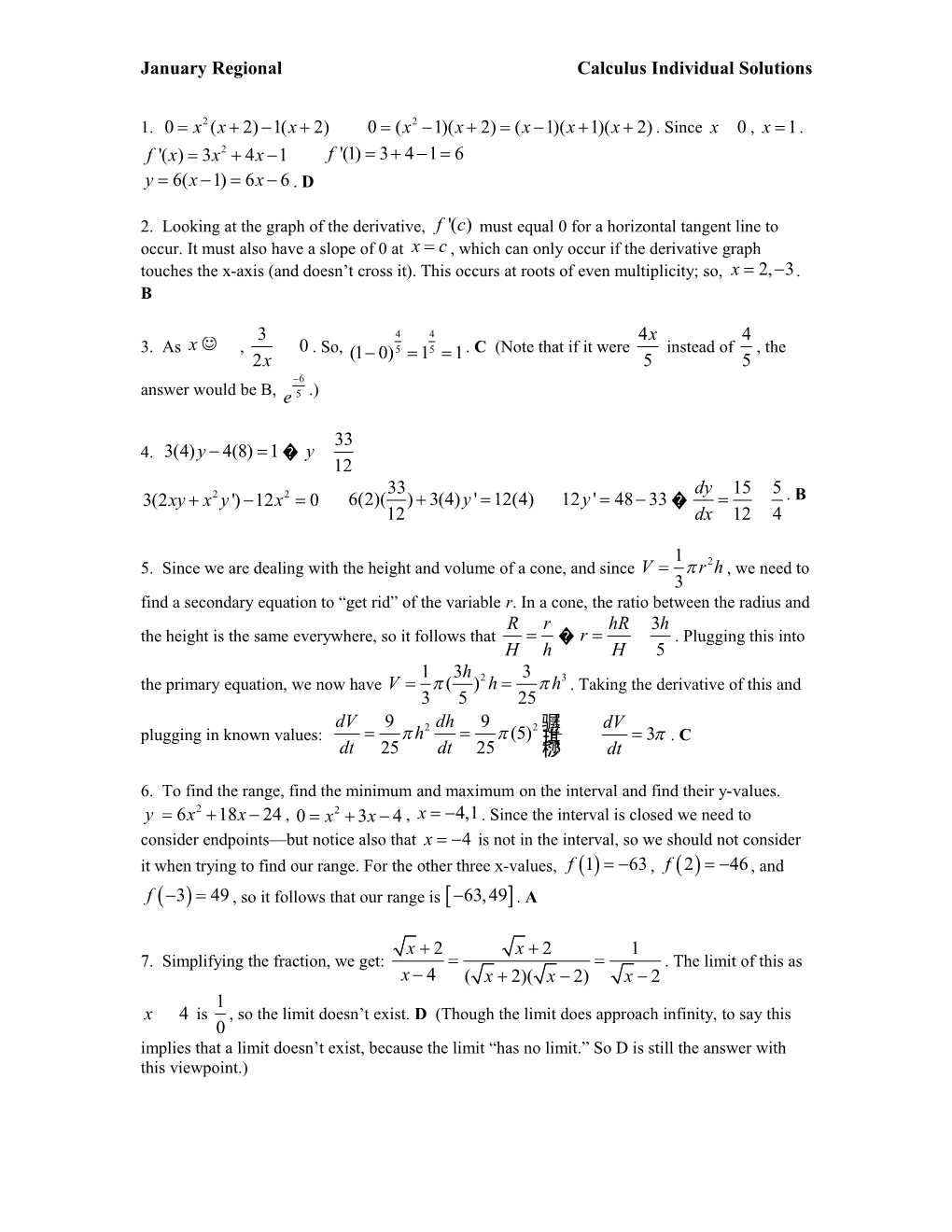January Regional Calculus Individual Solutions
1. . Since , .
. D
2. Looking at the graph of the derivative, must equal 0 for a horizontal tangent line to occur. It must also have a slope of 0 at , which can only occur if the derivative graph touches the x-axis (and doesn’t cross it). This occurs at roots of even multiplicity; so, . B
3. As , . So, . C (Note that if it were instead of , the answer would be B, .)
4.
. B
5. Since we are dealing with the height and volume of a cone, and since , we need to find a secondary equation to “get rid” of the variable r. In a cone, the ratio between the radius and the height is the same everywhere, so it follows that . Plugging this into the primary equation, we now have . Taking the derivative of this and plugging in known values: . C
6. To find the range, find the minimum and maximum on the interval and find their y-values. , , . Since the interval is closed we need to consider endpoints—but notice also that is not in the interval, so we should not consider it when trying to find our range. For the other three x-values, , , and , so it follows that our range is . A
7. Simplifying the fraction, we get: . The limit of this as is , so the limit doesn’t exist. D (Though the limit does approach infinity, to say this implies that a limit doesn’t exist, because the limit “has no limit.” So D is still the answer with this viewpoint.)
8. If , the approximation at becomes further and further away from the true value as x becomes farther and farther away from . The given interval suggests that and can give us our most deviant approximations. Using differentials, we obtain at and at . The latter answer is the larger over-approximation. B
9. Only satisfies all conditions. B would be correct except the constant c would be less than one in its higher-order derivatives. Therefore, C
10. Speed is increasing when velocity and acceleration are positive, or also when the two are both negative. Taking derivatives of the position function we get and . Analyzing the two functions tells us that both are negative on and both are positive on . So, speed increases on . E
11. Distinct roots ensure that the multiplicity of each root is 1. Since 1 is odd, the graph of the derivative will cross the x-axis, thus enabling the sign of to change, and thus making c a relative extremum of . The sign of the derivative will not change at a root if it only touches the graph, or if the root has multiplicity of even degree. B
12.
. A
13. . A
14. . B
15. To approximate area under:
. A
16. , . Therefore, . C
17. The function is defined on the interval . Since there is neither a limit from the left nor the right, even though the function is defined at there is no limit there. D
18. . So, slope of normal is A
19. We can factor the equations to produce the roots and intervals needed for our answer. By taking consecutive derivatives and evaluating their sign changes, we learn that is positive on , increasing on , and concave down on . The intersection of all these intervals is the interval . B
20.
. C
21.
. A
22. Roots are , , and . Therefore, . , so the sum of the roots is D
23. First fails at the third derivative. . C
24. Hannah’s numbers can be represented by and . . Maximum product occurs when , so . . A
25. The derivative of any constant is 0. For the second operation: . So, . B
26. . C
27. . Plugging in zero to each of the four functions gives a value of 1. So, the derivative of the four functions multiplied together is simply the sum of their derivatives. So, . B
28. Differentiability implies continuity. Set equations and their derivatives equal to each other at . For the derivatives, . Plugging this value of m into the original equation, . Therefore, . D
29. The function isn’t stated to be continuous, so conclusions made from the Mean Value Theorem (and consequently Rolle’s Theorem) are not valid. Choice C is clearly wrong because a function must both increase and decrease in order to return to the same value. E
30. ; . Zero velocity at maximum height; . Now, . It has zero height at the ground;
. C
